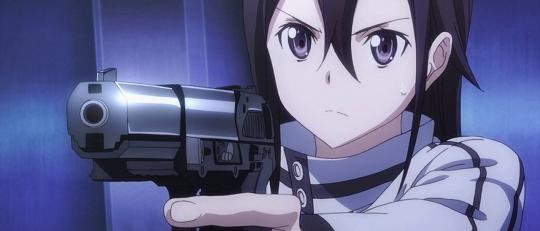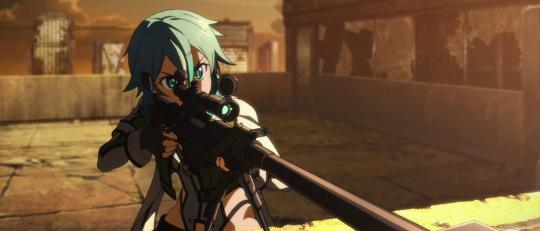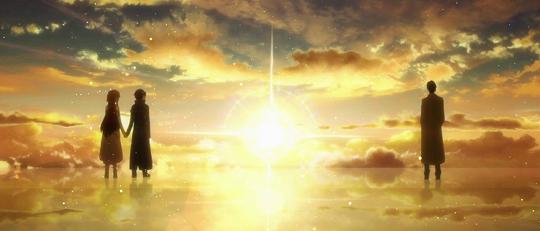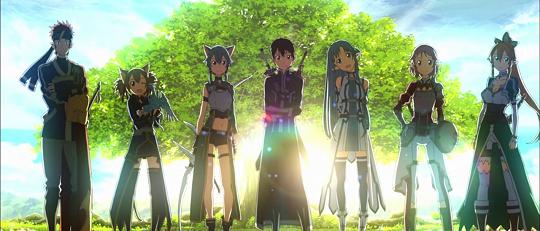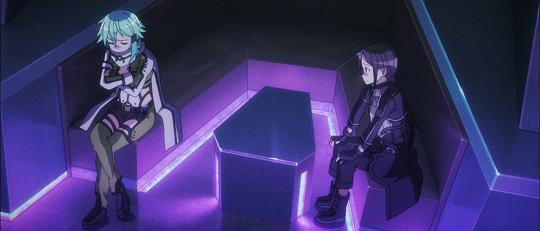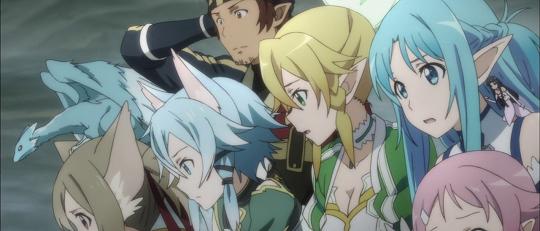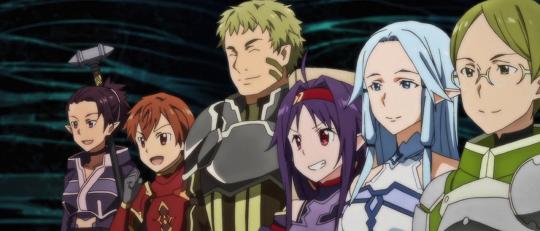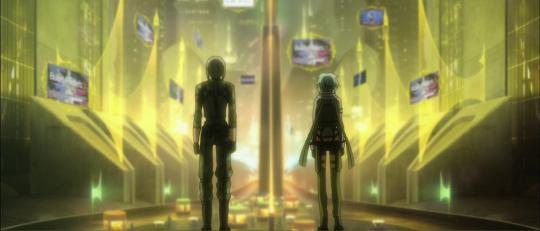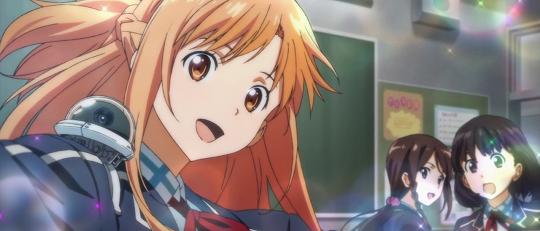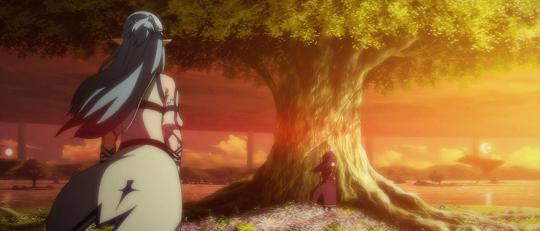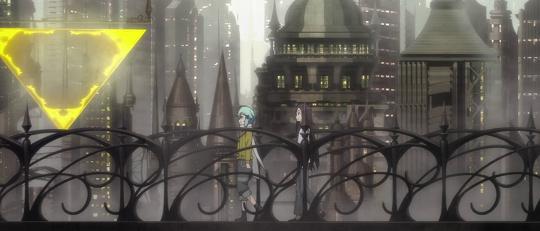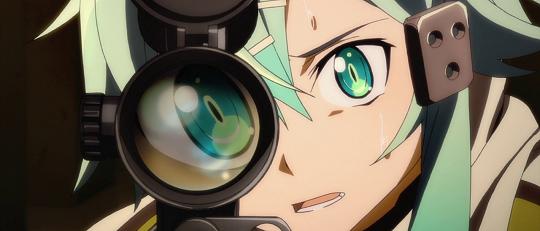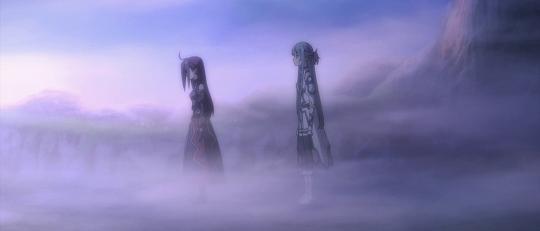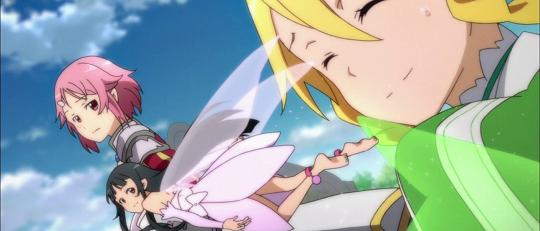Some way into this second series of Sword Art Online I found myself thinking that it was quite brave. Taking the clown-shoed silliness of the first series and slowing everything down, focusing on characters and setting, seemed like an odd decision. Like so many other aspects of Sword Art Online II though, I was disappointed. It’s not being brave, just invoking standard shounen-esque time wasting. Meaning if you watched the series as it aired you will have spent several weeks watching wunderkind Kirito and newcomer Sinon sit in a virtual cave in the middle of a virtual desert.
I shouldn’t really have expected anything else really. I liked the simplicity of the first series’ bifurcated storyline in a schlocky, intelligence-lite way, but the spark of that first storyline - trapped in a virtual world, die here and you die for real - was gone. Alfheim, the fairy filled fantasy funfair that occupied the second half of that series and is now the staple MMO for the core cast, was bright and cheerful but lacked the tangibility of Aincrad. It’s disheartening then that this second series kicks off by plunging Kirito into the grimy, gunmetal grey world of Gun Gale Online.
You see, nefarious deeds are afoot. A player killed in the virtual world died in the real world. The horror! Now it’s up to Kirito to solve the mystery because apparently gamesmasters, server administrators and log files don’t exist in the Sword Art Online world.
That’s immaterial though because this is the Kirito Show. Well, for a while it’s the Kiriko Show because Kirito’s avatar got gender switched to female due to, what I’m hoping, is to give weird fan art a jolly old boost. But the fact remains, Kirito is still the all singing, all dancing prodigy of online games that he was before. This game uses guns? No problem! Kirito uses a sword to chop the bullets right out of the air because Black Lagoon didn’t demonstrate exactly what happens to people who bring a sword to a gunfight. Aren’t these vehicles hard to use in game? Not for Kirito! Didn’t you glance at an article about someone several years ago? Eidetic memory Kirito to the rescue!
Imagine a character that is part Jesus Christ and part James Dean and you get the idea. The solution to any problem in this first story (oh there’s more) is usually just: Kirito. Forget about that Sinon character, all those frames dedicated to her derriere only ensure she’s set to become another member of his harem, just like the nurse who is inexplicably all soft-focus for him. Except we’re not supposed to remember he has a bevy of besotted females pining after him because he’s dating Asuna, and like a scatterbrained octogenarian the story forgets characters who are no longer germane to the story. The Navi-esque Yui for instance barely has one line of dialogue in the first ten episodes. Lisbeth and Silica? Who?
Yet despite the neutron-star draw of Kirito, Sinon manages to be the best part of the opening storyline. Bullied and suffering from PTSD after a particularly outlandish (especially for Japan) childhood incident, rather than seeking professional help she decides to immerse herself in Gun Gale Online where she, in a game comprised almost entirely of males, becomes renowned as a skilled lone-wolf sniper (is there any other kind?). Kirito though helps her overcome her crippling trauma, despite her gaining new one from being betrayed and almost raped by her best friend. Cest la vie.
Unfortunately this typifies what ends up being a core problem: interesting topics are there but never capitalised on. So Sinon’s PTSD is solved by talking with Kirito and meeting a figure from her past (with an adorable daughter, natch). Job done, dust off hands, next. Likewise the possibility of even acknowledging a female player’s treatment in male dominated games is ignored, even with the rich vein of possibility from Kirito’s gender swap. Or what about the virtual reality headsets that completely block out the outside world, could this be used for nefarious purposes Neuromancer style? It’s somewhat unfair to judge a series based upon what it doesn’t cover, but it seems that SAO is aware of its potential - both in setting and its reach with fans - but either doesn’t have the courage or the conviction to follow it through, instead going for the low-hanging fruit: melodrama.
No clearer is this than with the third and final story of the series which sees the introduction of yet another female - Yuuki; only sensing that Kirito’s development has, like a glacier, finally run its course and reached the ocean, the protagonist is now Asuna. It’s an interesting switch for a show that always championed the power fantasy that he embodied. But as expected, the story is unhappy with just some drama and goes full bore pathos porn. You can tell where the narrative arc is leading almost from the starting pistol: foreboding and cryptic sentences from Kirito (of course he’s still there dispensing wisdom), an angular and aloof mother just aching to connect with her daughter, and the knowledge that “ham fisted” doesn’t even begin to describe the plot thus far.
And so the inevitable happens and it’s heartbreaking and tearjerking and life affirming and full of promise but is, fundamentally, hollow. It’s encouraging that a topic like HIV/AIDS is part of the story, especially in a show that’s from a country that would really rather not talk about it, but it is used as an interchangeable catalyst rather than explored in any detail (check out the live-action movie Confessions for a more deft handling of the subject). Likewise, the potential medical applications of the wonderfully titled Medicuboid aren’t elaborated on, despite there being other people just there, ready for their part in the story. Religion? Sure why not we’ll add that to the list of things that Reki Kawahara read about that day.
Which is much of what the second, interstitial, story feels like when it comes to Norse mythology. Banging your head against an encyclopaedia would result in a better story than this one of Kirito and company questing in the less travelled corners of Alfheim. It’s this story - all three episodes of it - that feels the most like business as usual. There’s the buxom and overbearing sister and serial doofus Klein, all accompanied by sense of progression that the other sections of the series don’t have. Sure there’s Death Gun (which in Japanese sounds like Desu Gun or when Rozen Maiden went militant) in Gun Gale Online and the pleasant callback to Laughing Coffin of the first series, but as an antagonist he feels like a glass cannon rather than a genuine threat.
More tellingly though is that the second story is a lot closer to an MMO experience than any of the others. It still has the dissonance between individual fantasy and group achievement - Kirito’s party are after all irrevocably changing the game world - but the dynamic between the different characters plays well. Contrast this with the GGO story that despite being set in an online shooter world is effectively just Alfheim with different set dressing: the skillset, ruthlessness and drastically different culture involved in online face shooters is absent. The third story suffers the same problems as the second only more acutely by ignoring the idea that raid bosses are meant to be tackled by large teams for a reason, and regardless of the skill of the individual players that’s how they’re designed.
Except these monsters are generated rather than designed as the exposition that Kirito crowbar’s into the conversation elucidates, effectively writing off the immene time and craftsmanship that goes into designing and building MMO’s. That was always the central conceit of Sword Art Online though, that it may be set within an MMO but it crucially misunderstands even the basic concepts of them. The “you die here you die out there” of the first series was never the most interesting aspect and revisiting it for the major storyline of this series is like beating a horse that isn’t just dead but has already been turned into glue. The change in tone and protagonist for the last story threatens to encroach upon interesting territory with mobile remote-presences and alternative uses for the AmusPhere technology (invoking the spirit if not the name of Lain) but is undermined by turning the pathos all the way up to eleven.
Just like Asuna though, this series comes from money. It’s there in the gorgeous backgrounds and the beautifully detailed character designs and you can be sure it’s there when the action kicks in. Kinetic and smooth, A1-Pictures has pulled out all the stops here and even as Yuki Kajiura’s signature melodies swell in your ears and Kirito is swatting bullets with a lightsabre, it’s hard not feel a little fizz of excitement over it all despite its face-palm ridiculousness.
I ended my review of the first Sword Art Online series back at the start of 2013 by saying that despite being so silly and with myriad problems, it was still ruthlessly entertaining. That doesn’t hold true for the second series: despite nuggets of inspiration feels too much like three disparate stories strapped together into a twenty four episode bundle. Sinon may turn up as a cat-girl (what else?) in the second and third stories and Kirito’s sparkly sword from the second may turn up in the third, but for me, none of the parts are interesting on their own or as a whole. Without a narrative spine this is just Kirito, Asuna And Friends Play MMOs. If it were just that it would still be recommendable, but that it tries its hand at interesting, topical subjects and fails to even remotely honour them is monumentally disheartening.
As I’ve said before, I did still watch it through to its conclusion and, admittedly, felt a pang of sadness at the third story’s conclusion. It is still entertaining but somewhat more cynically so than before. A joy to look at and listen to but beyond that, there are better, albeit less raucous, alternatives out there.
